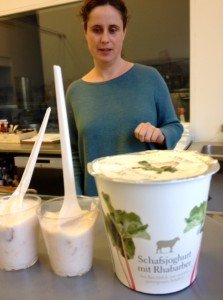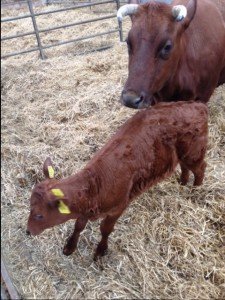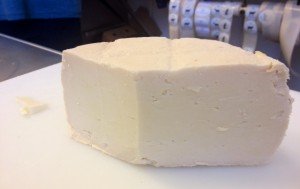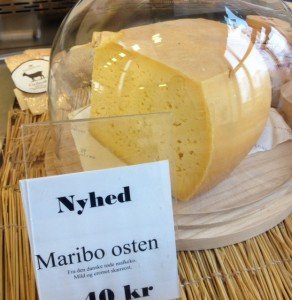It is not the first time that a wine trip serendipitously turned into a cheese excursion. Frederiksdal Kirsebærvin made me go to Lolland, in the very south of Denmark, and gorgeous it was and is – but I came also back with wonderful cheese. The Knuthenlund estate is run by Susanne Hovmand and her husband Jesper, and cheese making has been in the family since Susanne’s great-grandparents.
 Today Knuthenlund is an excellent example of the historic shift Denmark’s agriculture is experiencing since a few years, from efficiency-driven industrial to profoundly caring, holistic organic. Since 2007 the complete production has been driven by a biodiversity project that covers 300 of the estate’s 950 hectares. Old Danish blackspotted pigs are part of it, Susanne’s grandmother’s favored rhubarb variety features in it (it is used in a delicious sheep’s milk yoghurt), and recently old cheese recipes have been revived in the spacious dairy, using the milk from the first red Danish cows, an old variety that had almost disappeared.
Today Knuthenlund is an excellent example of the historic shift Denmark’s agriculture is experiencing since a few years, from efficiency-driven industrial to profoundly caring, holistic organic. Since 2007 the complete production has been driven by a biodiversity project that covers 300 of the estate’s 950 hectares. Old Danish blackspotted pigs are part of it, Susanne’s grandmother’s favored rhubarb variety features in it (it is used in a delicious sheep’s milk yoghurt), and recently old cheese recipes have been revived in the spacious dairy, using the milk from the first red Danish cows, an old variety that had almost disappeared.
 So far, sheep’s milk has been Knuthenlund’s specialty, and an excellent brie they make from it. More exciting to my tastebuds though is the washed-rind Rødkit: very dense and intense, with a lovely acidity and great aging potential (try it with the Frederiksdal Vintage!). Besides the 500 sheep they are milking each day at 3pm, until quite recently Knuthenlund used to have 300 goats. Susanne says unfortunately they were unsustainable because nobody wanted the meat – the same old problem for cheese makers everywhere…
So far, sheep’s milk has been Knuthenlund’s specialty, and an excellent brie they make from it. More exciting to my tastebuds though is the washed-rind Rødkit: very dense and intense, with a lovely acidity and great aging potential (try it with the Frederiksdal Vintage!). Besides the 500 sheep they are milking each day at 3pm, until quite recently Knuthenlund used to have 300 goats. Susanne says unfortunately they were unsustainable because nobody wanted the meat – the same old problem for cheese makers everywhere…
 I do hope they’ll be able to buy some goat’s milk in, because I found the unnamed cheese Jesper made from a a mix of goat’s and sheep’s milk totally intriguing. Mature, salty and rindless, it reminds me of the best Bavarian Weisslacker I ever tasted (and it pairs perfectly with the Frederiksdal Reserve).
I do hope they’ll be able to buy some goat’s milk in, because I found the unnamed cheese Jesper made from a a mix of goat’s and sheep’s milk totally intriguing. Mature, salty and rindless, it reminds me of the best Bavarian Weisslacker I ever tasted (and it pairs perfectly with the Frederiksdal Reserve).
 Just as exciting is their other new old cheese, Maribo, made from the red cows‘ milk. The curd is kneaded with salt, reminding me somewhat of the original cheddaring process, but then packed into the moulds and not pressed. It is clearly related to the Baltic tradition of Tilsiter cheese in acidity, but a little softer and less pungent, as the rind is kept clean by frequent brushing. Esrom, named after the old Danish abbey, obviously is another relative. Knuthenlund has a beautiful farm shop and café and loves to receive visitors – so go and taste for yourself.
Just as exciting is their other new old cheese, Maribo, made from the red cows‘ milk. The curd is kneaded with salt, reminding me somewhat of the original cheddaring process, but then packed into the moulds and not pressed. It is clearly related to the Baltic tradition of Tilsiter cheese in acidity, but a little softer and less pungent, as the rind is kept clean by frequent brushing. Esrom, named after the old Danish abbey, obviously is another relative. Knuthenlund has a beautiful farm shop and café and loves to receive visitors – so go and taste for yourself.
If you enjoyed reading this, you might consider clicking on the button below and supporting me in my work. I’d be more than happy. Thank you.
